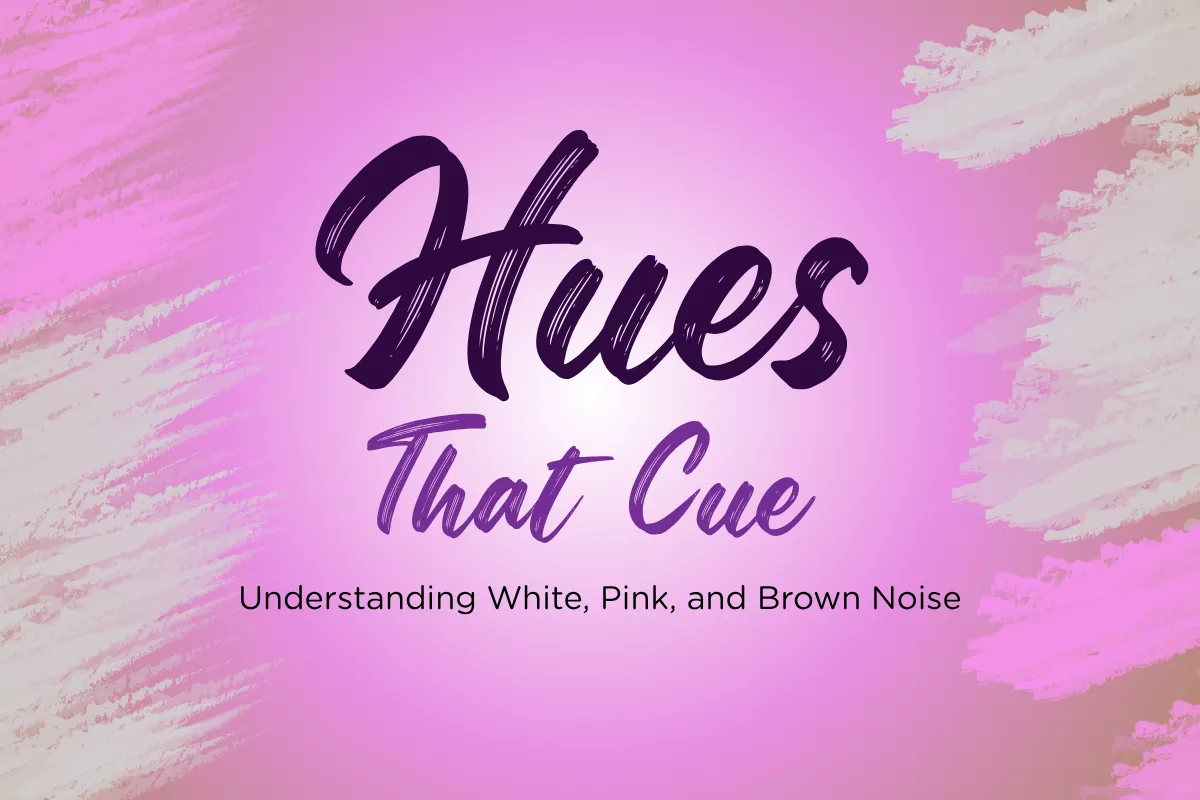General Inquiries: (587) 333-6349 - info@sanostate.com



Hues That Cue: Understanding White, Pink and Brown Noise
"... next time you're seeking a sonic sanctuary, consider indulging in the symphony of white, pink, or brown noise." - Dr. Blake Ausmus
Have you ever thought about associating colours with sounds? It may seem peculiar at first, as we don't typically describe a sound as "so red" or someone's voice as "green." However, there are three specific colours of noise that many of us are somewhat familiar with: White, Pink, and Brown. Let's delve into these intriguing hues of sound and discover their unique characteristics.
White Noise
White noise - how many people tell you that they can’t sleep without some white noise? Do you ask Alexa, or Google to play white noise for you at bed time? What white noise sounds like is static on a radio or television station not broadcasting anything specific. The reason it is called white noise is because it contains a broad spectrum of frequencies, just as white light contains all colours.

In school we learn that white is actually an accumulation of all the colours of the rainbow together. White noise works in the same way, it is just a big compilation of all sounds put together. The reason it helps with sleep is because it can drown out other noises that might be happening. So if the neighbour’s car alarm starts to go off just as you’re easing into sleep, it will be less distracting to you if it just adds to the white noise already going on.
Pink Noise
Pink noise - gets its name from the colour spectrum as well. Pink is an accumulation of multiple colours too, but it is not an equal amount of all, like white is. It is produced by having more in the lower range, and increasingly less as the frequency increases. Think of the rainbow colors as ROYGBIV. Pink noise is like taking more of the colors on the left side (red and orange) and less from the right side (blue and violet), resulting in a sound that emphasizes lower frequencies.
In this way, pink noise is a compilation of sound frequencies, but with a greater emphasis on the lower frequencies and a gradual decrease as the frequencies get higher. Some people notice pink noise to be more relaxing than white noise. One study found that when listening to pink noise the brains of the participants synchronized with the noise, and produced more steady lower frequencies. They also found that people had more stable sleep at night time- and during naps -while pink noise was playing.
Brown Noise
Brown noise - is a bit different, from our other tinged sounds. Interestingly, brown noise isn't named after the colour spectrum. Instead, it's named after the botanist Robert Brown, who discovered Brownian motion—random movement of particles in a liquid or gas. Brown noise sounds more like rolling thunder in the distance, with a deeper tone than white or even pink noise. Personally, I like to use brown noise to cancel out conversations when I’m in talk therapy sessions, so my loud voice doesn’t carry as easily into the hallway and waiting areas of the office.
For a clearer picture, here's a graph showing the frequency patterns of white (yellow line), pink (red line), and brown noise (blue line). You can see that white noise has equal amounts of all frequencies. Pink noise includes a higher amount of low frequencies, and less of the higher frequencies. And Brown noise has a similar pattern, but much more of the lower, and much less of the higher frequencies than pink noise does.

Make Some Noise!
In summary, white noise is great for masking distracting sounds, pink noise might offer a more soothing experience for sleepers or meditators with less high-frequency noise, and brown noise provides a deeper tone that can aid in focus or relaxation.
If you do a deeper dive into noises, you might find other colours in the spectrum like black noise, green noise, or purple noise. But, white, pink, and brown are the three that are most commonly used.
Exploring these types of noise can significantly impact your well-being. Whether you're seeking better sleep, enhanced focus, or relaxation, experimenting with white, pink, or brown noise might help you find the perfect sound for your needs.
So, the next time you're seeking a sonic sanctuary, consider indulging in the symphony of white, pink, or brown noise. Try out each one and see which ones help you with sleep, or to focus, or to relax!
Want to learn how your brain makes frequencies too? Get in touch for a free information session. Click HERE or call us at 587-333-6349 to connect!💙
References
Zhou, J., Liu, D., Li, X., Ma, J., Zhang, J., & Fang, J. (2012). Pink noise: Effect on complexity synchronization of brain activity and sleep consolidation. Journal of Theoretical Biology, 306, 68–72. https://doi.org/10.1016/j.jtbi.2012.04.006
Disclaimer
Our content is for informational and educational purposes and is not a replacement for professional advice, diagnosis, or treatment. If you're facing mental health concerns, please seek help from a qualified professional for personalized guidance. Every individual's situation is unique, so use the information here at your discretion. While we strive for accuracy, the field of psychology is ever-evolving, and our content may not always reflect the latest research. Please prioritize your privacy by avoiding sharing personal information in comments or interactions. Your well-being is our top concern, so use our content for educational purposes, but remember to rely on professionals for your specific needs.
Original post 2023. Edited and reformatted for 2025.
General Inquiries:
Our Locations:
Additional Resources:
About Us:
We strive for excellence in psychological treatment. We are committed to providing professional, caring, innovative, and research-based services.
© 2024 Sano State Taylored Psychology. All Rights Reserved.

